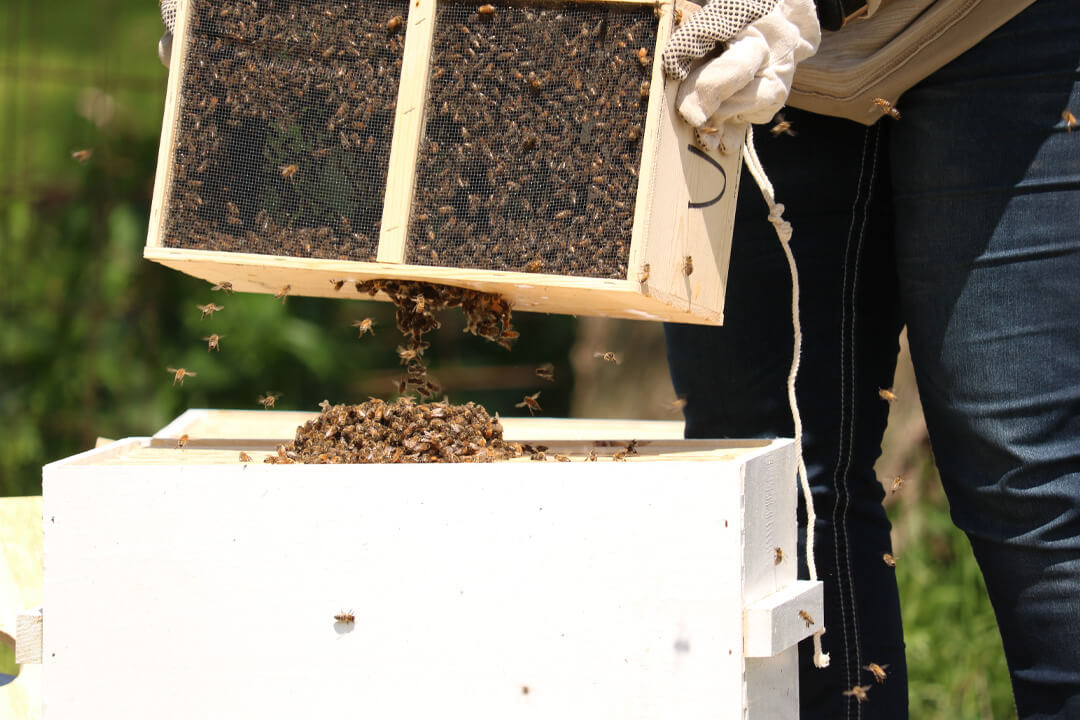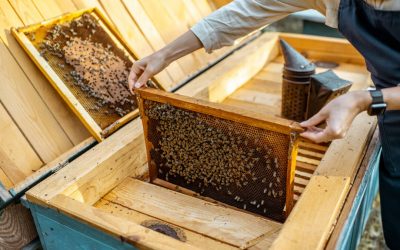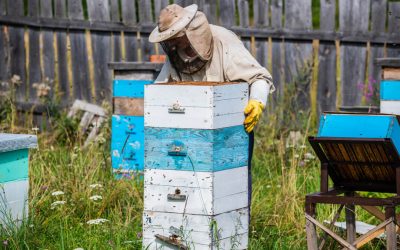What is a package of bees?
A package of bees usually consists of a queen bee and several worker bees. The queen is responsible for laying eggs, while the workers care for everything else, like building the hive and collecting pollen. When you buy a ‘package of bees,’ it comes in multiple boxes called ‘supers.’
There are three types of supers: the brood chamber, the honey super, and the pollen super. The brood chamber is where the queen lays her eggs. The honey super is where the worker bees store nectar and make honey. The pollen super is where the worker bees store pollen.
These boxes usually contain 12,000 worker bees, most weighing up to two to five pounds. That’s a lot of bees! So, it’s important to install them properly in your hive.
When to install a bee package
The best time to install a bee package is in the spring when the weather is warm, and there are plenty of flowers for the bees to forage on. However, you can install a package any time of year as long as the temperature is above 50F.
How to install a package of bees
There are a few different methods to install a bee package, but before you do any of these, make sure to spray the bees with sugar water. This will help them stay calm and prevent them from attacking you.
The shake method
This method is used when you have a hive that already has a comb built. To install the package, simply open the box and shake the bees into the hive. Then, put the empty box on top of the hive for the bees to use as a new home.
The newspaper method
This method is used when you don’t have a comb built yet. To install the package, crumple up some newspaper and stuff it into the entrance of the hive. This will block the bees from getting out. Then, open the box and place it inside the hive on top of the newspaper. The bees will build a comb on the newspaper and eventually chew their way out.
The direct release method
This method is used when you want to install the bees as quickly as possible. First, you remove the frames of the hive to create space for the bees to go in. Then, you open the box and pour the bees into the hive. Be careful not to pour them too close to the entrance, or they will fly out. Finally, put the frames back in and close up the hive.
Installing a bee package is a simple process that takes a little time and patience. But, with these helpful tips, you’ll be able to install your bee package like a pro!
How to install the queen bee
The queen bee is the most important in the hive. She is responsible for laying eggs, and without her, the hive will not be able to survive. That’s why it’s important to install her properly in the hive. It is suggested to have the queen bee in her cage for a couple of days before installation. This way, she can get used to her new surroundings and the other bees in the hive.
You can use two methods to install the queen bee: the cage method and the direct release method.
The cage method
This method is used when you want to install the queen bee without her getting out of the hive. To do this, you’ll need to purchase a queen cage. These usually come with a candy plug the worker bees eat to release the queen.
To install the queen using this method, simply put the cage in the hive between two frames. Make sure to put her in the middle of the hive so she can start laying eggs as soon as possible. Also, ensure the cage is facing the right direction so the bees can access the candy plug. This should give the worker bees enough time to eat through the candy and release the queen.
The direct release method
This method is used when you want to install the queen bee as quickly as possible. To do this, you’ll need to find the queen bee in the box and remove her from her cage. Then, you’ll need to hold her by the wings and gently place her in the hive.
After that, the worker bees will take care of the rest! Most of the time, worker bees will take care of the queen, but sometimes they might kill her. If this happens, you’ll need to install a new queen bee.
Why won’t my bees accept my queen bee?
If you’ve installed your queen bee properly and the worker bees are still not accepting her, there could be a few reasons. First, the queen may be too young or too old. It’s also possible that the hive is already too full of bees. If this is the case, the workers might not have enough room to take care of the queen.
Finally, it’s possible that the queen is not from the same hive as the workers. If this is the case, they might not accept her because she smells different.
If you’re having trouble getting your bees to accept your queen bee, you can try a couple of things. First, make sure she is the right age. Second, make sure the hive is not too full. Third, try giving her some time to adjust to her new surroundings. And fourth, if all else fails, you can try installing a new queen bee.
Unite your hive to another colony
When all else fails with your queen bee, you may be able to unite your hive with another colony. This is a process where you take two hives and put them together. This can be done by either putting the two hives next to each other or by taking frames from one hive and putting them in the other hive. Uniting your hive with another colony is a simple process that takes a little time and patience.
What to do after you install a package of bees?
After installing your bees package, you must first take care of a couple of things. You need to feed them. This can be done by either giving them sugar water or honey. Second, you need to check on them regularly. This means opening up the hive and making sure everything is okay.
Finally, you need to be patient. It can take a few days or weeks for the bees to adjust to their new hive. But eventually, they’ll get used to it and start producing honey!
If you need additional help getting started or managing your beehive, be sure to read our complete guide to beekeeping.
Conclusion
Installing a bee package takes a lot of patience and skill. But, with these helpful methods and tips, you’ll be able to do it like a pro beekeeper! Remember the methods we mentioned and try the one that best suits your needs. Good luck on your beekeeping journey!
Finally, you need to be patient. It can take a few days or weeks for the bees to adjust to their new hive. But eventually, they’ll get used to it and start producing honey!




